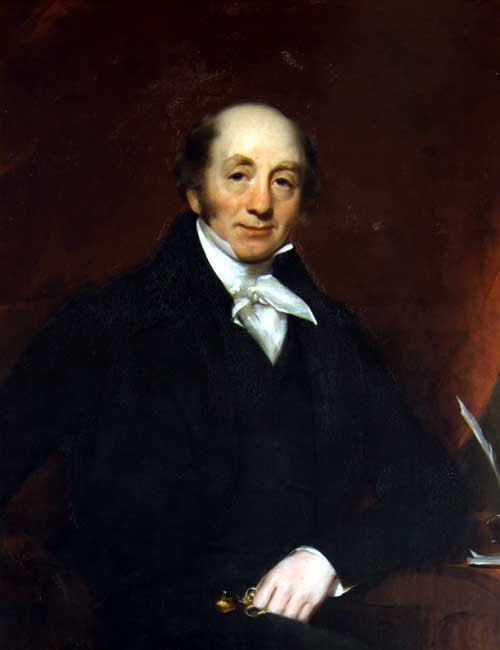 |
| Abraham Colles. Source. |
Abraham Colles was born in Kilkenny in Ireland in 1773. The story has it that as a boy he found an anatomy book in a field after a flood had destroyed a doctor’s house. He took the book to his owner, a Dr. Butler, who, finding he was so interested in it, let him keep it, perhaps sowing the seeds for his later choice of a medical career.
The Colles came generations ago from England, where they were a respectable family that had represented the city of Worcester in Parliament. Abraham’s father died when the boy was six years old, but his mother was able to provide him with a good education. At Kilkenny College he studied Johnathan Swift and George Berkeley; at Trinity College he wrote a paper on political satire that impressed Edmund Burke, and he also became apprenticed to a Dublin surgeon. He then went to Edinburgh University, where, working hard and living frugally, he graduated MD in 1797 with a thesis on venesection. He then walked all the way to London, covering 400 miles on foot in eight days. In London he attended some of its famous hospitals, and after a brief stint of working on hernias with Sir Astley Cooper returned to Dublin.
Teaching anatomy and surgery while establishing his own practice, Colles made a slow beginning. In his first year he earned a total of eight pounds. Later he secured appointments to several fever and maternity hospitals and in due course became the leading surgeon in Dublin. At age twenty-nine he was elected president of the Royal College of Surgeons in Ireland. In 1804 he became professor of anatomy, physiology, and surgery at the College.1 He was responsible for much of the early scientific development and prestige of surgery in Ireland, its separation from the barber-surgeons, education of the surgical students, and emphasis on anatomy and dissection. In 1838 he co-founded the Pathological Society of Dublin with the illustrious Drs. Robert Graves, Dominic Corrigan, and William Stokes.
As an anatomist, he described “Colles’ fascia,” the membranous layer of subcutaneous tissues of the perineum which by its attachment to the pelvic bones limits how urine accumulates in cases of urethral injury or disease.1 He described the inguinal ligament, sometimes still referred to as Colles’ ligament, and was the author of a treatise on surgical anatomy.
Despite his many teaching and administrative duties, Colles developed the most lucrative surgical practice in Dublin. He worked hard and was often in the dissecting room at six in the morning. He was a skillful surgeon, one of the first to treat a subclavian aneurysm by ligating the artery. A superior observer and diagnostician, he gave good practical and conservative advice. In 1837 he published a major treatise on syphilis and its protean clinical manifestations, describing its treatment with mercury and the importance of avoiding mercury toxicity. In Colles Law he claimed that a child with congenital syphilis could infect a wet nurse but not his mother, based on the erroneous assumption that an asymptomatic mother would not transmit the disease.
Colles also wrote on diseases of the anus and rectum, cancer, organic stricture, and fistula formation to the vagina or bladder. He described several students or colleagues developing severe and sometimes fatal sepsis and abscess formation after small scratches sustained in the dissecting room. He reported on peritonitis, pleuritis, synovitis, local nail infections, diseases of the nervous system including strokes, and ulcerations of the nasal sinuses and tongue, many of which he also treated with mercury.2 He improved the treatment of club foot, devising several ways of splinting the foot. He had a special interest in the treatment of Potts disease of the spine, insisting on maintaining patients with a gibbus or hunchback deformity in a horizontal position for at least one year, but emphasizing the need for fresh air and good nutrition.
Colles is best remembered for his paper on the fracture of the radius, the Colles’ fracture. Caused by a fall on the outstretched hand, it results in displacing the broken lower end of the radius backward. It is the most common of all fractures, occurring at some time in almost 15% of people, predominantly young people and the elderly. Colles described in his paper how the surgeon had to push back the dislocated part of the bone and he devised a tin and wooden splint for immobilizing it to ensure a good outcome.
Colles had ten children, of whom the eldest followed in his footsteps and became president of the Royal College of Surgeons of Ireland in 1863. Living in an age when medicine was emerging from the darkness of the previous centuries and entering a more scientific era, but still limited by the lack of effective therapeutic agents, Colles had to rely on venesection, leeches, purging with calomel, and mercury. He died in 1843 in his seventy-first year from congestive heart failure, a “surgical giant among surgeons.” It has been said that “no other surgeon of Ireland holds so secure a place in the history British surgery.”1
References
- Jones AR. The Journal of Bone and Joint Surgery 1950;328:126
- McDonell, R. Selections from the works of Abraham Colles, London. The New Sydeham Society 1881. West, Newman & Co, Printers, 54 Hatton Gardens, London
GEORGE DUNEA, MD, Editor-in-Chief

Leave a Reply